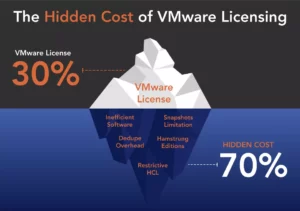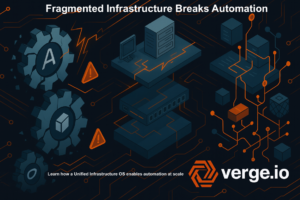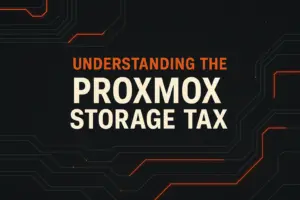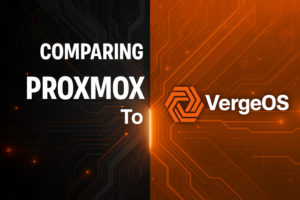At Verge.IO, we speak with two or three VMware customers daily, and they are all surprised when we expose VMware’s licensing paywall. Sure, they know the obvious upfront costs of VMware. Still, when they see the potential of VergeOS’s complete and fully integrated operating environment, they begin to understand that it is not just the cost of the license fee; it is also the cost associated with all the other modules or hardware you must buy because of the “modularity” of VMware’s offering.

In our upcoming webinar, “The 4 Hidden Costs of VMware,” we dive deep into ways that, from a technical standpoint, VMware’s technology uses a paywall that effectively keeps your organization from being competitive. In this article, we will focus specifically on how VMware’s modular licensing model costs you money.
The Expensive Nature of the Three-Tier Architecture
The data center has three tiers; networking, computing, and storage. The legacy three-tier architecture consists of the following:
- A network built from proprietary network hardware from companies like Cisco.
- A server tier virtualized by something like VMware vSphere or Microsoft Hyper-V.
- A storage tier built from proprietary hardware from companies like Pure Storage or Dell/EMC.
The problem with this approach is it is costly and complex to manage. It typically requires experts for each tier, raising operational costs. It also requires continuous fine-tuning to ensure each workload gets the correct performance level.
Failed HCI Created a VMware Paywall
A few years ago, VMware had the idea of expanding what it did to the server tier, and virtualizing the other two tiers. They brought to market vSAN, purchased what would become NSX, and ushered in the Hyperconverged Infrastructure (HCI) era. The promise was that life would be so much simpler for overburdened IT professionals.
Fast forward to today, and most organizations continue to run a traditional three-tier architecture, and IT pros are still beleaguered with IT tasks. What went wrong with HCI nirvana?
The first problem is that from a technology standpoint, the software-defined versions of networking and storage that VMware and others have brought to market pale in comparison to the specialized versions. There is also a challenge because each of these three software components is a separate code base, each representing double-digit millions of lines of code. Jamming them into a single server and attempting to scale out with multiple servers creates performance and scale issues. These technical issues require you to increase your hardware investment or stay with the legacy three-tier architecture. We explore them in our webinar.

The second problem is from a business standpoint. VMware charges a lot for these licenses, so the tried and true hardware approach remains more appealing. Then there are also the challenges of all of the different versions of VMware, each with its own set of limitations.
vSphere Essentials is a VMware Paywall
VMware Essentials and Essentials Plus are designed to provide small to medium-sized data centers with a cost-effective way to acquire VMWare. Essentials is limited to no more than three physical nodes and they are licensed to no more than six total processors. The typical configuration is a two or three-node cluster with two processors in each server. A processor with more than 32 cores consumes two of the processor licenses.
These solutions are priced aggressively but have the most expensive paywall to get through in order to get the features you need. Essentials features are as bare as you can get and, for the most part, provide only the virtualization layer. Essentials Plus adds the basics of what you hope to get by virtualizing servers like vMotion, Cross Switch vMotion, High Availability, and vSphere Replication. The upcharge to Essentials is significant, more than 10X the price!
Another example of VMware’s licensing paywall is that neither Essentials nor Essentials Plus includes vSAN. To get vSAN, customers need to purchase VMware HCI Kit Essentials, which is 3X the cost of Essentials Plus. The result is that most customers we speak to, use VMware Essentials Plus with a dedicated SAN, skyrocketing the infrastructure cost. As we discussed in our last article, “The High Cost of Dedicated Storage,” the delta of adding server class flash drives to a server instead of buying a dedicated array is significant. It is also important to note that neither of the two Essentials editions support Storage vMotion.
Remember networking? None of the three flavors of Essentials does much with networking beyond a virtual switch. If you want to use commodity switches instead of more expensive proprietary switches, VMware will offer you NSX. It also has more advanced capabilities like routing, firewalling, and virtual private networking. All of these capabilities can dramatically reduce data center costs, but the cost of NSX more than doubles the cost of the implementations.
VMware Essentials is a perfect example of why understanding the Total Cost of Ownership (TCO) is critical. VMware’s licensing paywall makes the TCO of your infrastructure increase with each upgrade. While the entry price may be very attractive, the total cost is not. The cost of forcing small to medium-sized businesses to use the proprietary network and storage hardware to avoid additional software licensing is significant. Each component is potentially 25X or more the cost of the Essentials software.
It doesn’t have to be this way! Both storage and networking components have long since been commoditized, with very reliable off-the-shelf alternatives available at a fraction of the cost. Yes, the software driving this hardware must be at least on par with the proprietary solutions. Again in our webinar, we will dive deep into that comparison.
Finally, there is the success penalty when your organization grows to the point that it needs more than three nodes or six processors in a cluster. The uplift from Essentials more than doubles, again, the price of your Essentials installation. Then you get to deal with a whole new level of modularity and feature compromise as VMware presents you with Standard Editions, Advanced Editions, Enterprise Editions, and Professional Editions, each with limitations and cost increases as you move to the next level.
vSphere Standard is a VMware Paywall
VMware’s licensing paywall doesn’t stop with Essentials. The story is the same for larger organizations already having vSphere Standard or vSphere Enterprise, except they are starting at a much higher price point. Pricing is still per CPU with limitations on the number of supported cores. As with Essentials adding vSAN or NSX doubles or triples the cost to license each CPU.
There are also upgrade options for “standard” users. For example, to get deduplication, you must upgrade from standard to advanced. You may be able to deduplicate data, but you inflate your price by almost 2X to get it. Do you want data-at-rest encryption? That is not in vSAN Advanced. You need to upgrade to Enterprise, almost doubling the price again!
Have you had enough?

The Paywall-Free TCO of VergeOS
VergeOS integrates the networking, hypervisor, and storage into a single cohesive code base. It is one piece of software, not three separate modules whose only integration is that the logos match. From a technology perspective, the common code base means VergeOS can deliver better performance and greater machine density, even using your existing hardware. From a TCO perspective, it means you can get your sanity back.
VergeOS is priced per Node. You are free to put as many processors, cores, as much RAM, and storage as you want in that node. There is no additional charge. VergeOS comes with complete Layer 2 and Layer 3 network functionality, enabling you to use commodity off-the-shelf switches when you are ready, and eliminate purchasing purpose-built hardware like firewalls. To experience all the power of VergeOS’ networking capabilities, watch our latest LightBoard video, “The Advantages of VergeOS Networking.”
VergeOS also includes powerful and efficient storage functionality, including the industry’s most advanced global inline deduplication, data protection, disaster recovery, and ransomware resiliency. It leverages flash drives and hard disk drives inside the nodes to deliver the highest performance levels at a fraction of the cost of traditional storage systems.
Operational costs plummet with VergeOS. Our single code base means an IT Generalist can administer the entire environment. Our intelligent learning algorithm eliminates the need to fine-tune and manage redundancy settings. It provides complete self-optimization and self-healing.
As you transition more of your infrastructure to VergeOS, your TCO continues to improve. Our most frequent type of customer is a VMware convert, followed closely by Hyper-V customers. In most cases, they start with an upfront cost reduction of 35% to 50% and drive toward a TCO of well over 70%.
Conclusion
If you have had enough of VMware’s licensing paywall limiting how your organization can fully leverage innovations in technology to lower costs and drive innovation, then it is time to take a look at VergeOS. Reach out to us to schedule a short technical overview of the difference VergeOS can make.


